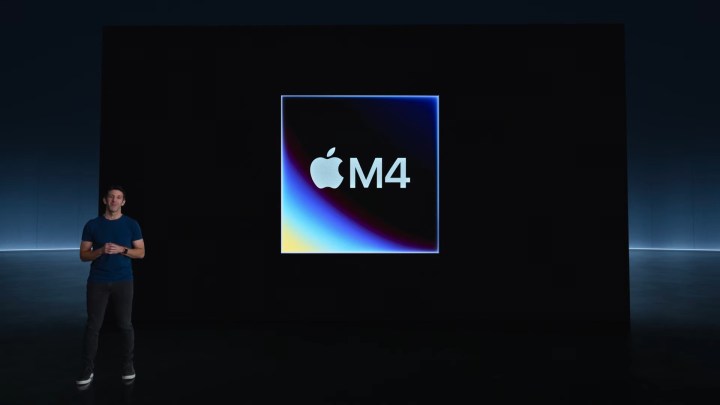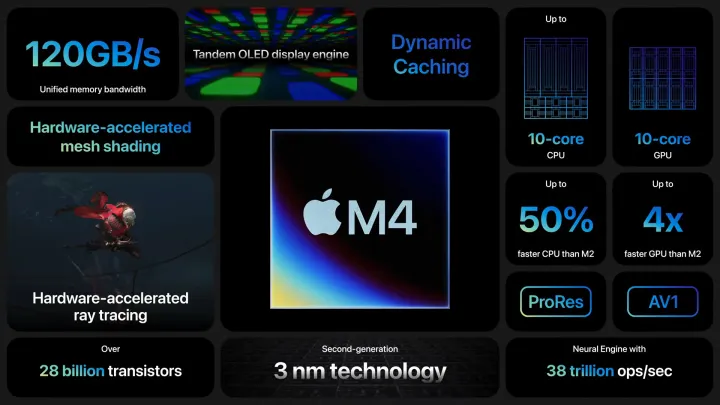
Apple has just announced a new slate of iPads, including an updated iPad Pro. What has that got to do with the M4 chip? Quite a lot, as those iPad Pro tablets come equipped with the M4, shockingly enough. That gives us plenty of info on what the chip might be capable of — and what it could be like when it finally arrives in the Mac.
But while Apple spilled the beans on the M4 in its iPad range, concrete details on how that chip will affect the Mac are few and far between. If you feel adrift without a compass and want to know what to expect, you’re in the right place. We’ve gathered up all the latest M4 chip rumors and known information in one place.
Price and release date

Normally, we would have expected the M4 chip to launch around fall 2024, as that would be about a year since the M3 series was unveiled. Anything sooner would have been very surprising and left recent buyers of M3 Macs feeling a little put out.
And yet, here we are with an M4 iPad Pro having just launched at Apple’s Let Loose event. It feels weird for all kinds of reasons, not least because it’s the first time an iPad has received new-generation Apple silicon chip before a Mac. Because orders are available today, the M4 iPad Pro will be out in the public in just one week, giving us a better idea of just how powerful it is.
Does that mean that it’s open season on M4 Mac rumors, with new Apple laptops and desktops about to launch any day now?
We’re not so sure. When it comes to M4 Macs, the earliest we’re likely to see those is probably in the fall. Bloomberg reporter Mark Gurman has said Apple wanted to launch the M4 iPad Pro in May so that it can talk about its iOS 18 artificial intelligence (AI) software updates “without distraction” at its Worldwide Developers Conference (WWDC) starting on June 10. So, while it’s certainly a possibility to see some M4 Macs launching next month, it’s not an obvious shoe-in.
That would mean the regular fall launch window is the most likely time we’ll see the M4 appear inside a Mac.
In fact, we might have to wait longer than that. Gurman himself has said he expects the first M4 Macs to debut around the end of the year, while industry analysts at Canalys have pegged the first quarter of 2025 as a probable release date. The most powerful M4 chip — the M4 Ultra — probably won’t be seen until mid or late 2025, given that Apple normally releases its top-end Macs around this time.
Performance and features

One reason the M3 series of chips had notable performance improvements compared to the M2 was that they were made using a 3nm process, as opposed to the M2’s 5nm process. This upgraded process meant that the chips could offer greater output while also tuning up efficiency in a double whammy of benefits to users. What about the M4?
Well, Apple revealed some interesting details at its iPad event on May 7. There, Apple hardware exec Tim Millet explained that the M4 is made using a second-generation 3nm process that is more efficient than what came before it (looking into the future, Apple isn’t expected to debut its first 2nm chips until 2025 at the earliest). As well as that, there’s an all-new display engine, while both the CPU and the GPU have been tuned up.
Starting with the CPU, it comes with four performance cores and six efficiency cores. Apple says the CPU is 50% faster than that found in the M2 (although it didn’t mention performance compared to the M3). The 10-core GPU, meanwhile, comes with dynamic caching, ray tracing and hardware-accelerated mesh shading, and it offers up to four times the rendering performance of the M2, Apple says.
In terms of efficiency, you’ll get the same level of output for half the power draw compared to the M2, according to Apple. And when put up against what Apple says is a leading PC chip in a thin and light laptop (Apple’s not naming names), Apple declares you can expect the same performance while using just a quarter of the power. So while we won’t know for sure until we can review an M4 device, Apple is clearly confident that its new chip offers a lot of performance while keeping cool and quiet.
As well as that, the M4 contains an updated 16-core Neural Engine that can perform up to 38 TOPS (trillion operations per second). Apple says it’s more powerful than any neural processing unit in any AI PC today, which is an important claim for Apple’s rather slow approach toward reacting to the outburst of interest in generative AI.

Speaking of AI, Apple is reportedly going to put a heavy focus on this area at it WWDC, with a huge range of new AI features expected to come to iOS 18 and the next version of macOS. Rumors claim that Apple wants its products to perform most AI tasks on-device, and if that’s the case, it’s going to need chips that can handle the increased workload. This is something the M4 is expected to excel at.
When it comes to the most powerful chip in the M4 range (the M4 Ultra), there’s a potentially momentous change that might be on the way. As claimed by YouTube channel Max Tech, the M3 Max reportedly does not feature Apple’s UltraFusion tech. This is what has previously allowed Apple to stitch two M2 Max chips together to create the M2 Ultra. If the M3 Max doesn’t have this feature, it suggests the M3 Ultra (if it launches) and, by extension, the M4 Ultra will be their own standalone chips rather than two Max chips fused together. That could mean better performance scaling compared to previous generations.
We’re also hoping Apple will bump up the base memory in its MacBooks from 8GB to 16GB. As the memory is built directly into Apple’s chips, that’s something that could mean a sizable change in the M4 series. If Apple is serious about AI, this is an upgrade that could really help.
Which devices will get the M4?

We can make an educated guess as to which Macs will end up with the M4 chip, as well as which will get the higher-end variations like the M4 Pro, M4 Max and M4 Ultra.
Starting with the M4, this is likely to land in the MacBook Air (both 13-inch and 15-inch sizes), the entry-level 14-inch MacBook Pro, the iMac and the Mac mini. Given the chip will be at the lower end of Apple’s hierarchy, it makes sense to expect it in more consumer-facing devices. That said, it’s in the new iPad Pro, which Apple touts as a very powerful device.
Moving onto the more pro-grade chips, we can expect the M4 Pro to end up in the 16-inch and 14-inch MacBook Pro and the Mac mini as an upgrade variant. The M4 Max, meanwhile, should come to the 16-inch and 14-inch MacBook Pro and the Mac Studio.
Finally, look for the flagship M4 Ultra inside the Mac Studio and Mac Pro. Those aren’t expected until some point in the second half of 2025, though, so there will probably be quite a wait until we see them in action.
Editors’ Recommendations
Services Marketplace – Listings, Bookings & Reviews